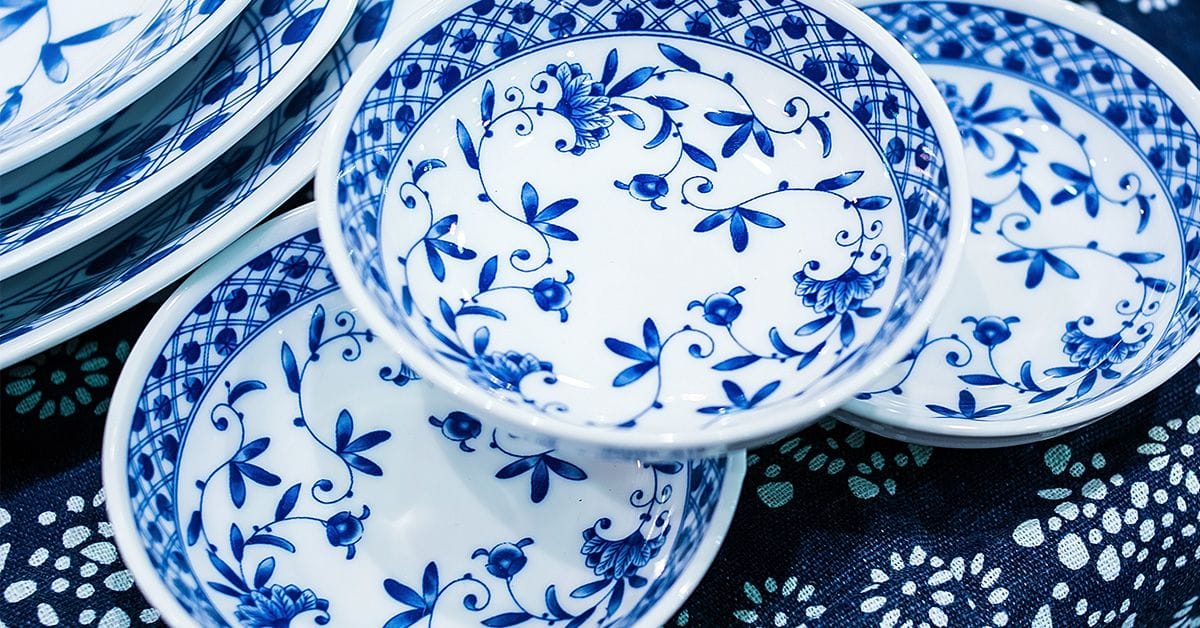Cobalt oxide is one of the most important pigments for many potters, but with sustainability and ethical questions surrounding mining practices, can we continue to rely on cobalt for this purely aesthetic use? Or can chemistry step up to the plate with an alternative?

In pottery, the shaped clay body—whether coiled or slabbed or thrown on the wheel—is fired before decorations are added with a range of pigments, oxides, and glazes. A glaze is essentially a mixture of powdered minerals similar to glass, but with the addition of alumina (Al2O3) and metal pigments.1
After a second firing, these colored mineral layers fuse to the clay, forming a glassy coating which delivers a smooth surface, shine, and a watertight skin. How this comes out can be variable, depending on application thickness, interactions with other glazes and oxides, and the firing temperature—not the mention any Kiln Gods or Goddesses one may have sitting around.2
After carefully controlling every aspect of the build up to this point, the average potter often abandons all expectations when choosing and applying a glaze. Blues have been popular in ceramics for centuries, and typically come from cobalt oxide. Globally, 187,000 metric tons of cobalt are mined every year,3 and an incredible 8% of that goes into blue pigments for ceramics,4 used by enthusiastic home potters, artists, and commercial tableware producers alike. But cobalt mining is an unregulated industry that relies on hand tools, and has been linked to child labor.5 To get around this, we have several options: recycle it, find alternatives, or use less.6
Ditching Cobalt for Carbon in Lithium-Ion Batteries
The good news is that there are solutions in progress. In new work published in ACS Applied Optical Materials, researchers developed new blue pigments using BaAl2Si2O8 (barium feldspar-based) materials, doped with cobalt, via a solid-state synthesis method.7 Feldspars are common, making up over 50% of the earth’s crust.8 Some of them, such as labradorite and moonstone, can also be very beautiful. But this particular barium feldspar is interesting because it can exist in monoclinic, hexagonal, or orthorhombic crystal forms—which means the material is able to hold impurities within its structure as well as shift between the different forms upon application of heat.
To create the pigments, the researchers ground BaCO3, Al2O3, SiO2, and Co3O4 mixtures in an agate mortar, shaped them under pressure, and then sintered them at high temperatures to form a sheet-like mixed raw material. Following synthesis, these pigments were combined with ceramic glazes and tested for color quality and stability.
The new blue pigment exhibited exceptional stability under both acidic and alkaline conditions—a rarity in ceramic pigmentation that promises longevity and durability for products. When applied to ceramics, the pigments melded beautifully with the glaze, producing a bright, appealing blue that maintained its luster and hue even in harsh environments. Importantly, the researchers say that this new powder substantially reduces the amount of cobalt needed to achieve the same effect, resulting in a cheaper, easier-to-produce blue ceramic pigment.
Previous work has investigated using powders made from oxides of copper, yttrium, indium, and manganese instead. For example, YIn1–xMnxO3 is a blue pigment with a trigonal bipyramidal hexagonal monolayer crystal structure that can also be doped.9 Adding lithium or zinc results in a rich blue with high infrared reflectivity. Tunable blues have also been developed from hibonite that rival the durability of both cobalt and YInMn blue.10 But not all of these options have great thermal stability, which makes them unsuitable for the high temperatures of a pottery kiln.
Cobalt-doped BaAl2Si2O8 is a promising solution for a new blue option in pottery that extends beyond just aesthetics—this new pigment has the potential to contribute to more environmentally friendly production processes in ceramics and other industries while also providing a safer alternative to traditional cobalt blues.
Curious about the detailed science behind this exciting new blue? Read the full research article below to learn more about the research that is setting a new standard for environmental responsibility in the world of ceramics.

Application and Properties of Co2+-Doped BaAl2Si2O8 Blue Pigments in Glazes
DOI: 10.1021/acsaom.3c00419
References
- Wicks, J. L. and Coppage, R. H. An Introduction to Ceramic Glaze Color Chemistry. In: Contextualizing Chemistry in Art and Archaeology: Inspiration for Instructors. Chapter 16, pp 403–424. ACS Symposium Series Vol. 1386.
- Geiger-Ho, M. Origins of Kiln Gods. In: The Worship of Kiln Gods: From the Temples of China to the Studios of Western Potters. Outskirts Press 2012.
- Distribution of cobalt demand worldwide in 2022, by application. Statista 2024. www.statista.com.
- The Problem With the Colour Blue In Pottery. Oxford Clay 2024. www.oxfordclay.co.uk.
- Sovacool, B. K. The precarious political economy of cobalt: balancing prosperity, poverty, and brutality in artisanal and industrial mining in the Democratic Republic of the Congo. Extr. Ind. Soc. 2019, 6, 915–939.
- Lee, S. and Manthiram, A. Can Cobalt Be Eliminated from Lithium-Ion Batteries? ACS Energy Lett. 2022, 7, 9, 3058–3063.
- Wang, Z. et al. Application and Properties of Co2+-Doped BaAl2Si2O8 Blue Pigments in Glazes. ACS Appl. Opt. Mater. 2024, 2, 2, 313–322.
- King, H. M. Feldspar. geology.com.
- Zhang, M. et al. Environmentally Friendly High-Near-Infrared Reflectance Blue Pigment YIn0.9–xMn0.1MxO3−δ Based on Li/Zn Doping. ACS Sustainable Chem. Eng. 2022, 10, 41, 13877–13886.
- Duell, B. A. et al. Hibonite Blue: A New Class of Intense Inorganic Blue Colorants. ACS Omega 2019, 4, 26, 22114–22118.
